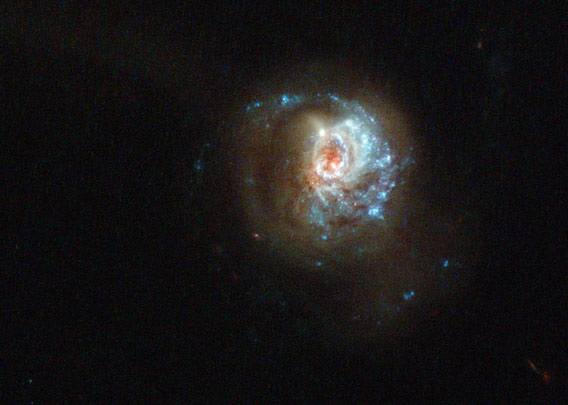Create a free profile to get unlimited access to exclusive videos, sweepstakes, and more!
Galaxies Are Weird and Weirdly Beautiful

Galaxies, on the whole, are very pretty. I find that interesting, actually; we didnât evolve to see galaxies with our naked eyes, and they exert no selective pressure on us to breed, so when we find them so attractive it must be coincidence. Their shape, color, and structure just so happen to fit our definition of beauty. Appreciating the art of the Universe is a collateral benefit of evolution.
And then thereâs this galaxy, prosaically named J125013.50+073441.5 (after its coordinates on the sky). I have to admit Iâm admiring its strange appeal.
What an odd thing! It's located about 500 million light years away, and has clearly suffered a massive collisionâwhile it does have spiral arms, the overall structure is a mess, indicating some large disturbance happened not too long ago. Most likely another galaxy came along, and the mutual gravity of the two drew them together, creating chaos in their structures. Thereâs no other nearby galaxy in the image, so I suspect the two wound up merging, and weâre catching it a few hundred million years after the event. The ring in the center and the small straight spurs around it are relatively common features seen in the aftermath of collisions as well, formed by the gravitational interaction of one galaxy as it plunges into another.
The image, taken using Hubble Space Telescope, is rather unusual, spanning a wide range of wavelengths of light. Itâs a composite of three observations, one in the ultraviolet (shown as blue in the image), one in visible light which accentuates normal starlight (shown as green), and near-infrared which highlights dust (red).
Ultraviolet light is emitted by young, massive, hot stars (and the gas surrounding them, lit by the intense radiation), and those tend to be born in spiral arms. Thatâs why the arms look blue. There's so much ultraviolet light being emitted, so much star formation going on, that J1250 is labeled a "starburst galaxy"âagain, that tends to be an effect of galaxy collisions, when massive clouds of gas slam into each other, collapse, and furiously form stars. The dust is all over the place, and really does look like it was stirred up by the collision. Dust is actually made of complex organic (carbon chain) molecules, created when stars are born and when they die.
In the Hubble release for this image, they mention this galaxy was observed as part of the Lyman Alpha Reference Sample research; a survey to look at galaxies that emit a lot of a special kind of ultraviolet light called Lyman Alpha. As it happens, I wrote about this survey recently when Hubble released a spectacular image of another targeted galaxy, which I think should be called Cinderellaâs Slipper.
The survey is helping astronomers understand galaxy formation and evolution by looking at nearby galaxies that can be used as models for far more distant ones. Closer ones are easier to study, while more distant ones may appear only as dots. The closer ones allow us to separate out various features (like the center of the galaxy versus an extended halo of gas) that are unresolved in the more distant galaxies. Itâs a clever idea, and very useful for understanding what galaxies were like when the Universe was much younger.
And it does provide us with a bit of eye candy along with that nutritional brain fodder, too. Iâm not an evolutionary biologist, so Iâm no expert in the whys and wherefores of our appreciation of the beauty of the Universe. But I do know what looks lovely to me, and I also know that the science behind that beauty adds to it, giving it depth and personality. Art is always supplemented by the knowledge of how it came to beâ¦especially when itâs on a grand a scale as the cosmos itself.


























